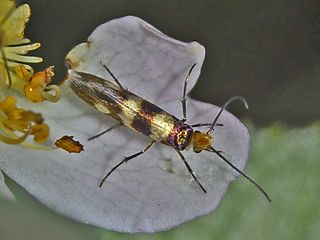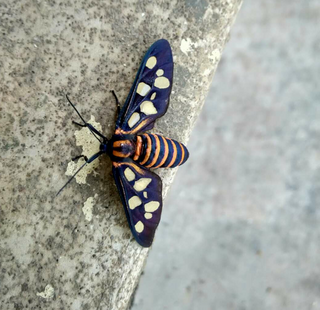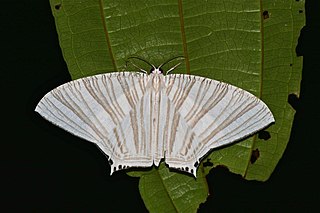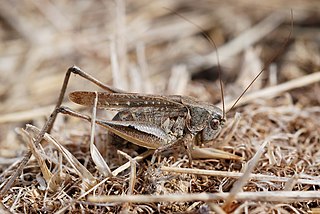
Pentatomidae is a family of insects belonging to the order Hemiptera, generally called shield bugs or stink bugs. Pentatomidae is the largest family in the superfamily Pentatomoidea, and contains around 900 genera and over 4700 species. As hemipterans, the pentatomids have piercing sucking mouthparts, and most are phytophagous, including several species which are severe pests on agricultural crops. However, some species, particularly in the subfamily Asopinae, are predatory and may be considered beneficial.

Mocis frugalis, the sugarcane looper, is a moth of the family Erebidae. The species was first described by Johan Christian Fabricius in 1775. It is found in several parts of the world, including India, Sri Lanka, West African countries and other Oriental regions. The adult is a fruit piercer and a major pest of crops.

Lomographa bimaculata, the white-pinion spotted, is a species of geometer moth. It belongs to the large geometer moth subfamily Ennominae, and therein to the tribe Baptini. It is – under its junior synonym – the type species of its genus Lomographa. It is also the type species of Bapta, a junior objective synonym of Lomographa and the namesake of the Baptini. The species was first described by Johan Christian Fabricius ion 1775.

Orthonama obstipata, the gem, is a moth of the family Geometridae. The species was first described by Johan Christian Fabricius in 1794. It is a cosmopolitan species. In continental Europe though in the northeast, its range does not significantly extend beyond the Baltic region and it is absent from northern Russia. This well-flying species is prone to vagrancy and able to cross considerable distances of open sea; it can thus be regularly found on the British Isles and even on Iceland.

Orthosia incerta, the clouded drab, is a species of moth of the family Noctuidae, found in Europe and Asia. The occurrence of the species extends through all European countries through the Palearctic to the Russian Far East and Japan. It is absent from northern Fennoscandia and in the Alps it occurs up to 2000 m above sea level.

Coccinella transversalis, commonly known as the transverse ladybird or transverse lady beetle is a species of ladybird beetle found from India across southern and southeastern Asia to Malesia and Australia. It is not to be confused with Coccinella transversoguttata, a widespread species in Europe and North America also known as the transverse ladybird. The alternative vernacular of small transverse ladybird may be used for C. transversalis in instances where these two species are discussed together.

Epagoge is a genus of moths belonging to the subfamily Tortricinae of the family Tortricidae. The genus was erected by Jacob Hübner in 1825.

Aethes smeathmanniana, or Smeathmann's aethes moth, is a moth of the family Tortricidae. It was described by Johan Christian Fabricius in 1781. It is found in most of Europe, Asia Minor and in North America, where it has been recorded from New Jersey and Newfoundland and Labrador.

Elachista gleichenella is a moth of the family Elachistidae found in most of Europe.

Olindia schumacherana, also known as the white-barred tortrix, is a moth of the family Tortricidae found in most of Europe. The moth was first described by the Danish zoologist, Johan Christian Fabricius in 1787.

Micropterix allionella is a moth of the family Micropterigidae. It was described by Johan Christian Fabricius in 1794.

Basiothia medea, the small verdant hawk, is a moth of the family Sphingidae. It is common in open habitats throughout the Ethiopian Region, including Madagascar. It is however probably absent from the equatorial forest belt, except as a vagrant. The species is an active migrant.

Dysauxes punctata is a moth of the family Erebidae. It was described by Johan Christian Fabricius in 1781. It is found in France, Portugal, Spain, Switzerland, Austria, Italy, Croatia, Bosnia and Herzegovina, North Macedonia, Greece, Turkey, Romania, Ukraine, Russia and North Africa.

Amata passalis, the sandalwood defoliator, is a moth of the family Erebidae first described by Johan Christian Fabricius in 1781. It is found in Sri Lanka and India.

Eriopygodes imbecilla, the Silurian, is a moth of the family Noctuidae first described by Johan Christian Fabricius in 1794.

Strophidia caudata is a moth of the family Uraniidae first described by Johan Christian Fabricius in 1781. It is found in the Indian subregion, Sri Lanka, to Peninsular Malaysia, Borneo and Sulawesi.

Polytela gloriosae, the Indian lily moth or lily caterpillar, is a moth of the family Noctuidae. The species was first described by Johan Christian Fabricius in 1781. It is found in Sri Lanka, India and probably in Indonesia.

Epinotia caprana is a moth belonging to the family Tortricidae. The species was first described by Johan Christian Fabricius in 1798.

Platycleis grisea is a European species of bush crickets described by Fabricius in 1781. It is the type species of the genus Platycleis and therefore the tribe Platycleidini. This species is recorded from mainland Europe and northern Africa.



















